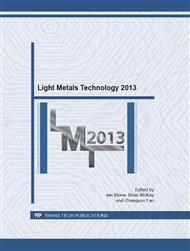p.648
p.653
p.658
p.663
p.668
p.673
p.678
p.683
p.688
Effect of Yttrium Ion on YSZ-Al2O3 Composite Coating Formed by PEO on a Cast Al-Si-Cu-Ni Alloy
Abstract:
Y2O3-ZrO2-Al2O3 (YSZ-Al2O3) composite ceramic coating was formed on a cast Al‑12Si-3Cu-2Ni alloy by plus AC plasma electrolytic oxidation (PEO) process, with yttrium ion concentrations varying from 0 to 0.5 g/l and process time from 0 to 45 min. The microstructures of the coatings were investigated by SEM and XRD. The results show that the PEO coating growth behaviour and microstructure were affected greatly by Y ion additions. At a given oxidation time, the coating growth rate accelerated and thickness increased in the PEO process when adding yttrium ions. When the content of Y ions is greater than the optimum value of 0.05 g/l, coating growth gradually decreases. In comparison with a ZrO2-Al2O3 coating, the amount of micro particle in YSZ-Al2O3 coating is less and the ceramic layer is repeatedly deposited by ceramic particles and good binding was achieved between the ceramic coating and the base alloy. The uniform and compact YSZ-Al2O3 composite coating is mainly composed of c-Y0.15Zr0.85O1.93 solid solution, m‑ZrO2, α-Al2O3, γ-Al2O3 and Y2O3 phases. The ZrO2 phase was well stabilized by solid solution containing yttrium element and Al2O3.
Info:
Periodical:
Pages:
668-672
Citation:
Online since:
July 2013
Authors:
Price:
Сopyright:
© 2013 Trans Tech Publications Ltd. All Rights Reserved
Share:
Citation:


